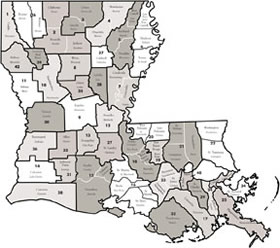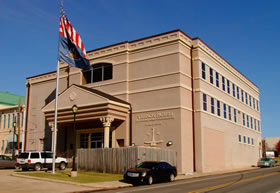The Court
Louisiana District Courts

Louisiana has 42 judicial districts, each with its own district court. Each of the districts serves at least one parish and has at least one district judge. Each district elects a chief judge.
The Louisiana state legislature has the authority to change the types of cases heard in the district courts, and the number of districts, by a two-thirds majority vote. As of 2007, the legislature may establish new judgeships for district courts as well.
Louisiana district court judges are elected in partisan elections for six-year terms. On recommendation of the state's judiciary commission, the Louisiana Supreme Court may discipline or remove district judges from office.
Jurisdiction of the 30th JDC
The 30th Judicial District Court is a general jurisdiction court for the State of Louisiana. As a general jurisdiction court, the 30th JDC's power and authority extends to all cases of a civil nature including but not limited to disputes between private parties over contract or property rights, claims for personal injury, marriage and family matters, estate, probate and succession rights, and other related matters. The 30th Judicial District Court also has criminal jurisdiction over misdemeanors, felonies or violations of parish ordinances committed in the territorial jurisdiction of Vernon Parish and presides over all stages of the criminal proceedings from the setting of bail or other conditions of release, the conducting of court for the determination of bail and probable cause, arraignments, motions and discovery, and the conduct of judge or jury trials on the determination of guilt or innocence, and other related matters. The 30th Judicial District Court further has juvenile jurisdiction and presides over cases involving a juvenile offender, children in need of supervision, delinquency proceedings and adoptions, and other related matters.
The Old Courthouse
On January 26, 1871, Senator J.B. Lewis of the Twenty-Second Senatorial District, then composed of De Soto, Natchitoches and Sabine parishes, introduced a bill entitled “An Act to Create the Parish of Vernon and Providing for the Organization Thereof.” On February 24, 1871, the bill was read for the third time and adopted by the senate. Three days later, the house of representative concurred, and Vernon Parish was born.
Construction of the first Vernon Parish Courthouse was begun during the spring of 1871. The structure, a two-story, wooden building, was built on the courthouse square facing eastward on Second Street. In 180, the Kansas City Southern Railway pushed through Leesville and took a portion of Second Street for its right-of-way. This apparently prompted the police jury to construct a new courthouse. Following the removal of the wooden courthouse, the two-story brick courthouse was constructed on the western portion of the courthouse square facing Third Street.
Unfortunately for Vernon Parish taxpayers, the new brick courthouse began to literally crumble shortly after its dedication due to faulty foundations. After several attempts to repair the new building a courthouse committee was again appointed in mid-June 1907, by the police jury to inspect the crumbling building; their findings revealed that the courthouse was dangerous and unsafe for occupancy. As a consequence, on August 5, 1907, the police jury passed an ordinance authorizing the construction of new courthouse.

The 1910 Vernon Parish Courthouse is a four-faced brick building with stone trim and completely painted white. The plan is basically that of a Greek Cross (all arms equal); however, the inside corners of the cross are bridged, thus making the plan into a Greek Cross diagonally superimposed on a small square. The part of the building running from front to rear is covered with a continuous gable roof with a classic portico at each end. A lofty dome rests on a quasi-square drum at the center of the roof. Four clock faces grow out of each side at the base of the metal-sheathed dome. The gable roofs covering the two side arms of the building are somewhat lower than the main roof and terminate into it. This accounts for the fact that the two classic porticoes here are not as tall as the other two, and their porches are extremely shallow. Except for the height and depth, the four faces of the building are almost exactly alike. Each presents four limestone unfluted Corinthian columns which support an entablature and a pediment. The only decorations of significance are stucco floral patterns radiating from the center of each pediment and the small triangular pediments with dentils over each of the four entrance doors. Originally cross halls ran through the centers of all arms; today, however, the rear hall has been blocked off to accommodate offices. The floors of the halls are paved with a mincled bluish-tan tile and the walls have wooden wainscoting. The building as a whole is beautifully proportioned, and it stands with dignity in its picturesque setting.
The “New” Courthouse

Originally built in 1907 as the First National Bank, the building was constructed in the style popular for large commercial buildings at the beginning of the 20th century. The lower floor housed the First National Bank and several retail stores. The upper floor was occupied by an opera house, known as the National Theatre. The bank closed during the depression but the Opera House continued to present traveling Vaudeville shows, symphony orchestras and opera companies for many years. After the Sliman family donated the building to the parish, in 2001 the interior was renovated for use as the Vernon Parish Courthouse. Although the main entrance is now on the western side of the building, the eastern facade has been completely preserved.
Office Hours
Contact us
- Mailing Address
P.O. Box 1700
Leesville, LA 71496 - Physical Address
215 S. 4th St.
Second Floor
Leesville, LA 71446 - Telephone
(337) 239-3584 - Fax
(337) 238-0961
